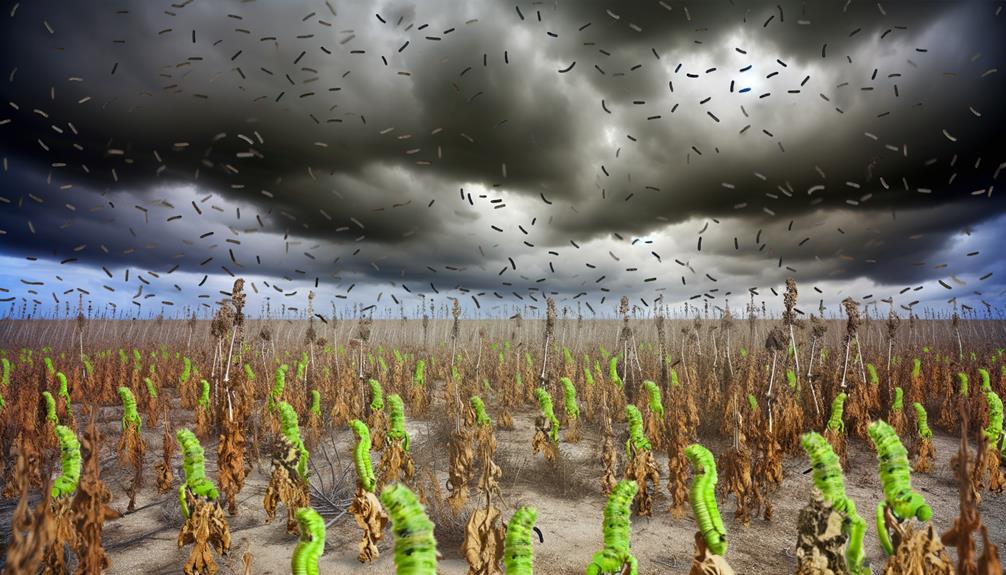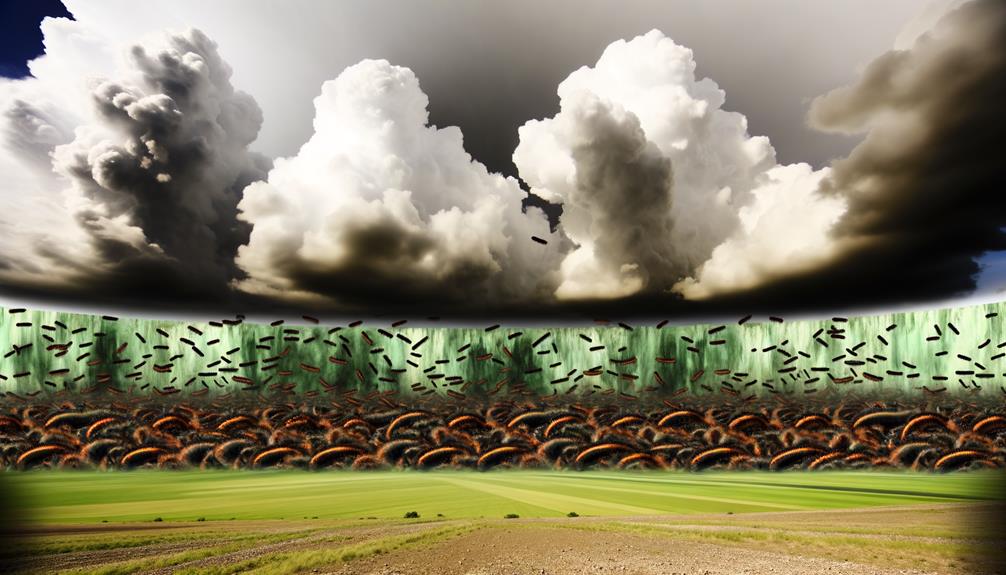Caterpillar Meaning in the Bible: Transformation
In the Bible, caterpillars symbolize divine judgment and spiritual desolation, as seen in Joel 1:4 and Nahum 3:15-16, where they exemplify the devastating effects of locust plagues on agrarian societies. These creatures represent moral decay, illustrating the consequences of turning away from God.
However, their transformative nature also points to themes of spiritual renewal and repentance, akin to the metamorphosis described in Romans 12:2. The presence of caterpillars in Scripture serves as a stark reminder of both divine retribution and the hope of transformation for those who seek redemption.
Discover more about these profound biblical insights.

Caterpillar Meaning in the Bible: Symbolism of Destruction and Divine Judgment
| Aspect | Details |
|---|---|
| Definition | A larval insect often used in scripture as a symbol of consuming judgment |
| Key Bible Reference | Joel 1:4 – “That which the palmerworm hath left hath the caterpillar eaten” |
| Symbolic Meaning | Destruction, divine judgment, consequences of sin |
| Spiritual Insight | God uses even small creatures as instruments of correction and warning |
| Moral Lesson | Spiritual neglect invites decay, but repentance can lead to restoration |
Biblical References to Caterpillars

The Bible mentions caterpillars primarily in the context of divine judgment and natural calamities, as seen in passages such as Joel 1:4 and Nahum 3:15-16.
In Joel 1:4, the prophet describes a sequence of devastating locust plagues, including caterpillars, to illustrate the severity of God’s impending judgment on a disobedient Israel.
Similarly, Nahum 3:15-16 addresses the catastrophic downfall of Nineveh, utilizing the imagery of caterpillars to emphasize total devastation.
Historically, these references resonate with the agrarian societies of ancient Israel and Assyria, where locust invasions were a real and terrifying threat.
Consequently, caterpillars serve as potent symbols within the biblical narrative, underscoring themes of divine retribution and the fragile nature of human prosperity.
Symbolism of Destruction

In the Bible, caterpillars often symbolize impending destruction, as seen in Joel 1:4 where they are agents of divine judgment, consuming what locusts have left behind.
This metaphor extends to depict extensive spiritual devastation, serving as a stark warning of the consequences of disobedience to God.
Historically, such imagery reflects the agrarian society’s vulnerability to plague, illustrating a broader theological message of repentance and divine retribution.
Biblical Plague Significance
Biblical depictions of caterpillars, particularly within the context of plagues, signify divine judgment and the devastating consequences of disobedience, as exemplified in Joel 1:4 where the successive waves of locusts and caterpillars symbolize relentless destruction.
The theological depth of this symbolism is profound, reflecting:
- Divine Retribution: Caterpillars, as agents of devastation, represent God’s retributive justice against unfaithfulness.
- Continuity of Judgment: The repetitive nature of plagues underscores the persistence of divine judgment until repentance is achieved.
- Historical Context: In ancient Israel, agricultural destruction by pests would lead to famine, emphasizing the severe socio-economic impact of divine wrath.
Understanding these elements enhances comprehension of the biblical narrative, highlighting the importance of obedience and the severe repercussions of straying from divine commandments.
Metaphor for Judgment
Caterpillars, as depicted in scriptural texts, serve as a potent metaphor for divine judgment, illustrating the devastating consequences of straying from God’s commandments.
In the book of Joel, locusts and caterpillars represent invading forces that ravage the land, symbolizing the desolation wrought by divine retribution (Joel 1:4).
Historically, such imagery resonated deeply with agrarian societies whose livelihoods depended on the land’s fertility.
The catastrophic plagues of Egypt further underscore this theme, where locust invasions decimated crops, reinforcing the notion of divine punishment (Exodus 10:12-15).
This metaphor not only underscores the gravity of divine displeasure but also serves as a vivid reminder of the spiritual and material desolation that follows disobedience to God’s laws.
Spiritual Devastation Symbol
When examining the symbolism of caterpillars within scripture, one finds that they often embody the spiritual desolation resulting from a community’s estrangement from divine principles.
Biblically, caterpillars are frequently depicted as agents of destruction, symbolizing the consequences of turning away from God. For instance, Joel 1:4 describes a locust invasion, including caterpillars, as divine retribution for Israel’s disobedience.
This imagery underscores:
- Spiritual Decay: Reflecting the erosion of faith and moral decay within a community.
- Divine Judgment: Serving as instruments of God’s disciplinary actions.
- Necessity for Repentance: Highlighting the urgent need for spiritual renewal and return to divine guidance.
Thus, caterpillars in biblical texts serve as potent symbols of the profound impact of spiritual neglect.
Metaphors of Renewal

The metamorphosis of a caterpillar into a butterfly serves as a profound biblical metaphor for spiritual renewal and transformation, echoing themes found in passages such as Romans 12:2 and 2 Corinthians 5:17.
In Romans, Paul encourages believers to be ‘transformed by the renewing of your mind,’ signifying a profound inner change.
Likewise, 2 Corinthians 5:17 declares that ‘if anyone is in Christ, the new creation has come: The old has gone, the new is here!’
Historically, early church fathers like Augustine used natural processes to illustrate divine truths, hence the caterpillar’s transformation has long symbolized the believer’s journey from old self to new creation.
This metamorphosis embodies hope and the promise of spiritual rebirth.
Divine Judgment and Caterpillars

While the metamorphosis of a caterpillar illustrates spiritual renewal, scripture also presents caterpillars as agents of divine judgment, as seen in passages like Joel 1:4 and Deuteronomy 28:38. These references highlight the severity of divine retribution and the consequences of disobedience to God’s commandments.
Historically, these instances of caterpillar infestations serve as:
- Symbols of Devastation: Joel 1:4 describes successive waves of locusts, including caterpillars, as a divine punishment.
- Warnings to Repentance: Deuteronomy 28:38 uses the image of caterpillars consuming crops to admonish Israel to remain faithful.
- Manifestations of Divine Power: Such judgments underscore God’s control over nature and His willingness to use it as a means of correction.
This understanding deepens our grasp of the multifaceted symbolism of caterpillars in biblical texts.
Lessons From Transformation

In considering the transformative journey of a caterpillar into a butterfly, the Apostle Paul’s exhortation in Romans 12:2 to be ‘transformed by the renewing of your mind’ finds a vivid metaphor in the natural world’s process of metamorphosis.
The caterpillar’s journey through stages of growth, culminating in the emergence as a butterfly, mirrors the spiritual maturation that Paul advocates. Historically, the early Church Fathers interpreted this transformation as an illustration of sanctification—an ongoing process of becoming more Christ-like.
This metamorphosis requires shedding old habits and embracing new, godly virtues, reflecting the profound change that true spiritual renewal entails. Consequently, the caterpillar’s transformation underscores the necessity of continual growth and renewal in the Christian life.
Spiritual Implications in Scriptures

Exploring the spiritual implications in scriptures, the metaphor of the caterpillar’s transformation profoundly resonates with the biblical theme of renewal and rebirth as seen in passages like 2 Corinthians 5:17, which speaks of becoming a new creation in Christ. This transformation aligns with numerous scriptural themes:
Repentance and Renewal: Joel 2:25 discusses restoration, symbolizing how God can transform destruction into renewal.
Spiritual Growth: Romans 12:2 emphasizes the need for a transformed mind, akin to the caterpillar’s metamorphosis.
Resurrection and Eternal Life: 1 Corinthians 15:42-44 correlates the caterpillar’s life cycle with the resurrection, illustrating the shift from perishable to imperishable.
These scriptures offer profound insights into the transformative journey of faith, mirrored in the caterpillar’s metamorphosis.
Modern Interpretations

Modern interpretations of the caterpillar in biblical texts often extend its symbolism to contemporary contexts, emphasizing themes of transformation and renewal found in Romans 12:2.
Today’s spiritual lessons draw parallels between the caterpillar’s metamorphosis and personal growth, suggesting that individuals can undergo profound internal changes through faith.
In addition, this metaphor serves as a poignant reminder that periods of struggle and transformation are essential for achieving spiritual maturity and enlightenment.
Symbolism in Today’s Context
Interpreting the symbolism of the caterpillar in today’s context invites a nuanced exploration of transformation and renewal, echoing the profound spiritual themes found in biblical narratives. Modern interpretations often draw from both scriptural references and historical contexts to uncover deeper meanings.
Transformation: Just as the caterpillar undergoes metamorphosis, believers are called to spiritual renewal (Romans 12:2).
Patience and Timing: The caterpillar’s slow growth process parallels the biblical principle of waiting on God’s timing (Ecclesiastes 3:1).
Hope and New Beginnings: The eventual emergence of the butterfly symbolizes the hope of resurrection and new life in Christ (2 Corinthians 5:17).
These interpretations resonate deeply with contemporary spiritual journeys, offering insight into personal and communal transformation.
Contemporary Spiritual Lessons
In contemporary spiritual discourse, the metaphor of the caterpillar provides profound insights into the themes of spiritual growth, patience, and eventual transformation, as reflected in key biblical passages.
Scripturally, Romans 12:2’s call for transformation ‘by the renewing of your mind’ resonates with the caterpillar’s metamorphosis.
Historically, the caterpillar has symbolized a period of preparation and unseen growth, akin to the Israelites’ wilderness journey before reaching the Promised Land.
Theologically, this metaphor emphasizes the necessity of enduring trials and embracing divine timing, paralleling James 1:4’s admonition for patience to perfect faith.
In today’s fast-paced world, these lessons advocate for a deeper, more contemplative spiritual practice, encouraging believers to trust in God’s transformative process.
Metaphors for Personal Growth
Building upon the profound spiritual insights drawn from the biblical metaphor of the caterpillar, the concept of personal growth in modern interpretations similarly underscores the transformative journey of faith and development.
The caterpillar’s metamorphosis into a butterfly can be seen as a symbolic representation of spiritual rebirth and enlightenment. This process can be broken down into three key stages:
- Caterpillar Stage: Represents initial faith and the beginning of spiritual awareness (Romans 12:2).
- Cocoon Stage: Symbolizes periods of introspection, challenges, and transformation (James 1:2-4).
- Butterfly Emergence: Reflects the attainment of spiritual maturity and a renewed sense of purpose (2 Corinthians 5:17).
This metaphor vividly illustrates the continuous and evolving nature of personal and spiritual growth.
Conclusion
The juxtaposition of caterpillars as agents of destruction and symbols of renewal in scriptural texts underscores the duality of divine judgment and grace.
Biblical references, from Joel to Revelation, highlight caterpillars as instruments of divine retribution, yet their metamorphosis also signifies potential for spiritual rebirth.
Historical and theological contexts reveal profound lessons on the transient nature of suffering and the promise of transformation, inviting contemplation on the multifaceted nature of divine narrative.






